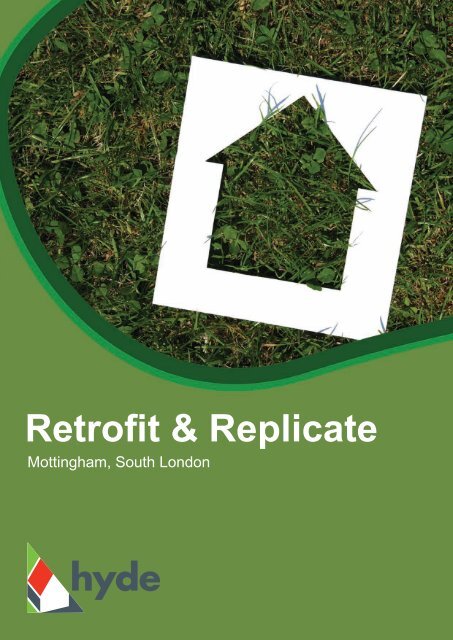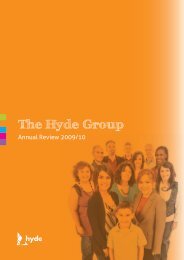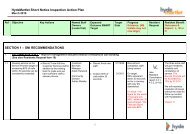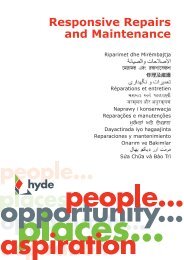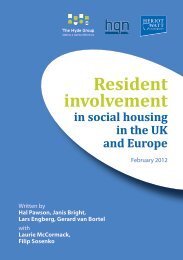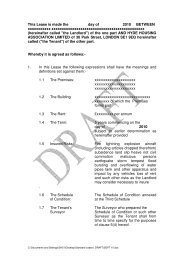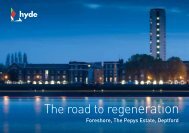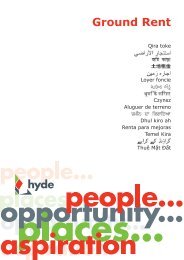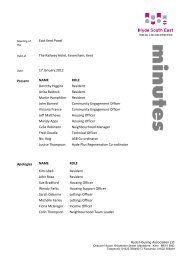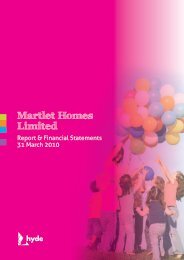Retrofit & Replicate - Hyde Housing Association
Retrofit & Replicate - Hyde Housing Association
Retrofit & Replicate - Hyde Housing Association
You also want an ePaper? Increase the reach of your titles
YUMPU automatically turns print PDFs into web optimized ePapers that Google loves.
<strong>Retrofit</strong> & <strong>Replicate</strong><br />
Mottingham, South London
<strong>Retrofit</strong> & <strong>Replicate</strong><br />
Project Briefing<br />
Project Background: Whilst the environmental focus of the house-building industry has been on new<br />
build and the Code for Sustainable Homes, improving the energy efficiency of the nation’s existing housing<br />
stock presents a far more important challenge in terms of helping to combat climate change. Our existing<br />
stock is typically very inefficient compared to new build housing in terms of energy use, yet less than 20% of<br />
existing homes are likely be replaced by 2050.<br />
ECD Architects have a long-standing interest in this issue and a track record in exemplar refurbishment in<br />
the residential sector. Similarly, <strong>Hyde</strong> <strong>Housing</strong> <strong>Association</strong> have strong policies on sustainability and, with<br />
responsibility for over 40,000 dwellings mainly around the south and south-east of England, they were also<br />
very interested in the potential of low-carbon refurbishment. ECD approached <strong>Hyde</strong> late in 2007 with a<br />
proposal to undertake an exemplar retrofit project and in January 2008 they identified a suitable void property<br />
- a 3-bedroom mid-terrace house in Mottingham, south-east London, typical of their stock.<br />
Most analysis of retrofit focuses on targets for reducing carbon emissions - the Government’s Energy White<br />
Paper (2007) officially stated the UK’s target to reduce its net carbon emissions by 60% by 2050, which will<br />
become a legal obligation once the Climate Change Bill is passed (currently due late 2008). The Review<br />
of Sustainability of Existing Homes, produced by the Department for Communities & Local Government in<br />
November 2006, declared that the country’s existing housing should fall in line with this target.<br />
However, the Existing Homes Alliance and others argue for greater targets – the EHA Declaration states<br />
“deep cuts of at least 80% in carbon emissions are needed by 2050, with major progress by 2020”. Recent<br />
proposals suggest that the Government is likely to adopt this higher target. The EHA Declaration goes further<br />
to propose the approach that must be taken with regard to our existing dwelling stock - “Government and<br />
industry action should focus on developing a ‘whole house’ approach which applies packages of low carbon<br />
improvements, rather than individual measures, using existing, proven energy efficiency and microgeneration<br />
technology. Improvements to water and other resource use efficiency must be included. A whole-house<br />
approach brings greater economic savings to business and causes less disruption to households over time.”<br />
<strong>Retrofit</strong> initiatives to date have indeed focussed primarily on installing individual renewables or other lowcarbon<br />
technologies. <strong>Hyde</strong> and ECD therefore agreed that the aim of this project would be to establish the<br />
most effective overall package of retrofit measures necessary to achieve the 80% reduction in CO 2<br />
emissions<br />
at the Mottingham house and to monitor the performance of the low-carbon improvements in use. In addition,<br />
it will record the impact of the retrofit on the incoming tenants over a 24 month period and, at the end of that<br />
time, develop a full cost/benefit analysis, with a view to ascertaining the optimum expenditure. This will enable<br />
<strong>Hyde</strong> and others to make the more efficient and effective choices about how best to apply energy saving<br />
as part of large scale retrofit programmes. This project will therefore be of huge benefit both in terms of the<br />
developing national policy and of helping to frame the approach of individuals and organisations to retrofit.<br />
- 1 -
Design Team: ECD Architects are lead designer for the project and are drawing on their sister company,<br />
Keegans, to provide extensive cost consultancy and CDM co-ordinator services. Further consultancy input has<br />
been forthcoming from Parity Projects, with particular responsibility for the data monitoring aspects of the project.<br />
In addition to this quantitative feedback on energy and water use, another of ECD’s sister companies, PPCR,<br />
will undertake post-occupancy evaluation interviews with the incoming tenant providing valuable information on<br />
comfort and satisfaction.<br />
Following interviews and competitive submissions, Mears Ltd were selected as main Contractor partner and<br />
began working with ECD to develop the specification. Mears, in turn, introduced Travis Perkins and Kingspan as<br />
supply chain and technical partners respectively. We are working to a total capital budget of £80k (including VAT<br />
and fees) funded in the main from <strong>Hyde</strong> internal resources but with all partners and product contributors investing<br />
significant resources in the project. A full list of supply partners and their involvement has been included at the end<br />
of this document.<br />
The Existing Property: 225 Court Farm Road is thought to have been<br />
originally constructed in the late 1930’s as part of a large estate development.<br />
The external walls are of cavity wall facing brick construction and the original<br />
dwelling included suspended timber floors and pitched tiled roofs but no<br />
bathroom! Later improvements saw the inclusion of a first floor shower<br />
room, the replacement of open fires with a central heating system of<br />
gas combination boiler with radiators and the addition of a single-storey<br />
rear extension comprising a third bedroom and ensuite bathroom. Fabric<br />
improvements over time have seen the addition of double glazing (though<br />
of poor quality) and 100mm loft insulation to the pitched roof, though the flat<br />
roofed extension included only 25mm mineral wool insulation. A solid concrete<br />
floor replaced the timber in the kitchen and the strip out works found that the<br />
original water supply was via lead piping and an asbestos tank, with no stopcock<br />
found on the premises. Further asbestos was found in the soffit boards.<br />
Initial design proposals investigated the potential for a loft conversion at the property but this was eventually ruled<br />
out due to a lack of headroom. There is an imperative to enlarge the first floor shower room and further space is<br />
required for hot water storage and electrical equipment (inverters, dataloggers etc). SAP assessments were carried<br />
out by ECD Project Services for the property, which was found to have a rating of 60, well above the national<br />
average of 48 and therefore presenting a significant challenge to achieve the 80% reductions. In March 2008,<br />
ECD assigned Heathrow Commissioning to undertake a ‘before’ airtightness test. The purpose of this test was to<br />
provide a ‘base case’ with which to compare the completed scheme and to highlight existing leakage points that<br />
need mitigation. The results were surprising – 9.16 m3/hr/m2 @ 50 pascals, which is better than current building<br />
regulation requirements. The windows were the source of the worst infiltration with poor seals leaking air badly,<br />
followed by incoming services penetrations and the loft access hatch.<br />
According to PHPP software, specific primary energy use (heating, DHW + auxilliary electricity) at the existing<br />
property is estimated to have been 414 kWh/m2/yr with CO 2 emissions rated at 100 kg/m2/yr and space heating<br />
demand rated at 223 kWh/m2/yr.<br />
- 2 -
The <strong>Retrofit</strong> Proposals: The ‘<strong>Retrofit</strong><br />
and <strong>Replicate</strong>’ strategy focuses on carrying<br />
out the most straightforward improvements<br />
to reach the 80% target . . . and on doing<br />
them well. The priorities are to minimise<br />
heat losses from the building fabric; to install<br />
an easily replicable, efficient form of space<br />
and water heating; to reduce the energy<br />
requirements for lighting; and to utilise<br />
the most appropriate renewable forms of<br />
micro-generation in reducing CO2 emissions<br />
associated to the property.<br />
Heat loss will be addressed though<br />
significantly improved insulation to floors,<br />
external walls and roofs, replacement<br />
high-performance windows and doors,<br />
consideration to the dwelling’s air permeability<br />
and the installation of a mechanical<br />
ventilation system with heat recovery from the<br />
extract air. In the choice of insulation material,<br />
thermal performance and ease of installation<br />
has been favoured over embodied energy<br />
and material source considerations, although<br />
minimal GWP and ZODP credentials were<br />
pre-requisites. U-value targets for the various<br />
envelope build-ups were set as follows:<br />
· Suspended timber floor – 0.2 W/m2K<br />
· External walls – 0.15 W/m2K<br />
· Pitched or flat roofs – 0.1 W/m2K<br />
mechanical ventilation unit, therefore access<br />
and available headroom were important<br />
factors, as was the poor condition of the<br />
existing roofing felt. Simultaneously, we<br />
were concerned about achieving good<br />
airtightness when recessed light fittings were<br />
introduced to the ceiling below. A combination<br />
of insulation products were therefore<br />
selected – Kingspan Thermapitch, laid on<br />
an airtight vapour barrier over the existing<br />
ceiling joists, and Web Dynamics’ TLX Gold<br />
multi-foil lining the existing rafters and party<br />
walls. The rigid boards are laid to the depth<br />
of an existing central bearer (170mm), thus<br />
allowing a floating floor deck to pass freely<br />
across the loft area. TLX Gold is the world’s<br />
first breathable multi-foil and the Court Farm<br />
Road project will be used as a case study<br />
and test-bed for both its ease of installation<br />
and performance in operation. This material<br />
will also allow the retention of the existing<br />
roofing felt and tiles by providing a secondary<br />
waterproof layer, as well as minimising the<br />
impact on headroom in the loft and reducing<br />
summer heat gains due to its reflective gold<br />
inner layer.<br />
to perform as a low-carbon dwelling. To<br />
ensure a reasonably airtight envelope, Mears<br />
will keep a log and photographic record of<br />
all service penetrations through the external<br />
walls and roofs to ensure they are sealed<br />
effectively.<br />
To provide controlled ventilation, a Vaillant<br />
recoVAIR 275 mechanical ventilation<br />
system is being retrofitted into the property.<br />
Mounted on the party wall in the loft space,<br />
the unit will extract air from the kitchen and<br />
bathrooms, reclaiming around 90% of the<br />
heat to pre-warm incoming fresh air which<br />
is then supplied to the living and bedrooms.<br />
In summer mode, a bypass extracts the air<br />
direct to outside.<br />
Phenolic foam insulation offers the best<br />
performance of any readily available panel<br />
and therefore has less impact on internal<br />
room dimensions where dry-lining is<br />
concerned – an important consideration for<br />
<strong>Hyde</strong>. Kingspan’s Kooltherm phenolic range<br />
was therefore selected for both suspended<br />
floors and external walls. For the main<br />
body of the house, insulation-backed K17<br />
plasterboard dry-lining panels were specified,<br />
whilst for the rear extension external K5<br />
wallboards with a silicone render finish<br />
provides the best solution. This element<br />
of the works was supplied and installed by<br />
Wetherby Building Solutions.<br />
For the rear extension roof Kingspan<br />
Thermapitch rigid polyurethane boards<br />
(220mm) were preferred, in conjunction with<br />
Knauf Carbon Zero glasswool in the eaves<br />
location.<br />
For the pitched roof element, a number of<br />
other factors came into play rather then<br />
straightforward thermal performance.<br />
The loft is to be used for locating plant<br />
such as the proposed thermal store and<br />
The existing double-glazed windows were<br />
shown to be the weakest building element<br />
during the airtightness test: they will be<br />
replaced with aluminium-clad NorDan Ntech<br />
Passive windows, which are triple-glazed with<br />
warm edge spacers and composite insulated<br />
timber frames, achieving an overall Uw-value<br />
of 0.7 W/m2K. Front and rear doors will also<br />
be replaced with insulated replacements with<br />
a Uw-value of 1.0 W/m2K.<br />
Details have been considered in terms of<br />
the abutment of insulation, avoidance of<br />
thermal bridging and continuity of the air<br />
barrier. As well as communicating installation<br />
requirements on 1:5 detail drawings, ECD<br />
held a workshop on site with Mears site<br />
team to explain the importance of their<br />
workmanship to these issues, together with<br />
background on how the building is intended<br />
- 3 -
With these measures in place, the space<br />
heating requirements at the property are<br />
estimated to reduce from 17,238 kWh/yr to<br />
2,410 kWh/yr – a drop of over 86%. With such<br />
low levels of heating required, tenant fuel<br />
bills will be significantly reduced. Capital cost,<br />
ease of retrofitting and ongoing maintenance<br />
requirements therefore become the most<br />
important driver in the choice of fuel source.<br />
Ground source heat pumps are relatively<br />
expensive to install and need to be located<br />
in a substantial, and preferably soundproofed,<br />
cupboard. Furthermore, to operate<br />
efficiently they work best in conjunction with an<br />
underfloor heating system, which in itself has<br />
inherent problems in a retrofit situation.<br />
The feasibility for underfloor heating was<br />
explored by ECD and Mears and found to be<br />
technically possible but only with a reduction<br />
in underfloor insulation levels and an increase<br />
in installation time and cost. When further<br />
confronted with a solid concrete floor in the<br />
kitchen, the concept was rejected in favour of a<br />
conventional wet radiator system. Heat pumps<br />
require electricity to operate, which in the UK is<br />
particularly carbon intensive – more than twice<br />
the kgCO 2<br />
/kWh than mains gas. Therefore to<br />
produce carbon reductions in comparison with<br />
an efficient gas condensing boiler, heat pumps<br />
need to achieve a Coefficient of Performance<br />
greater than 2.5 measured across the whole<br />
year – the recent trials at the Barratt EcoSmart<br />
show properties recorded a CoP of 2.6. Air<br />
source heat pumps are unlikely to improve<br />
upon these results at present and would also<br />
require underfloor heating. A biomass boiler<br />
was also ruled out by <strong>Hyde</strong> as it was thought<br />
to place an undue burden on the tenant to<br />
source and store a supply of wood pellets,<br />
and would again require additional plant<br />
space. With these considerations in mind, the<br />
decision was made to upgrade the existing<br />
gas boiler for a more efficient condensing unit<br />
and the Vaillant ecoTEC system was selected,<br />
with low NOx emissions and programmable<br />
controls. This was relocated to a hall<br />
cupboard since the existing flue outlet position<br />
contravened modern guidelines.<br />
The gas condensing boiler will also supply hot<br />
water to the property but will be supplemented<br />
by solar thermal collectors located on the<br />
pitched roof. The system is to be supplied<br />
and installed by Kingspan Renewables in<br />
conjunction with a twin-coil 250l Range Tribune<br />
thermal store located in the loft space. Two<br />
flat plate collectors mounted either side of<br />
the ridge will face east and west but will be<br />
controlled intelligently to favour the better<br />
performing panel as the sun tracks around<br />
the house to the south. It is hoped that 50-<br />
60% of the tenant’s hot water needs will be<br />
met by this system. All connecting pipework<br />
between boiler and thermal store will be well<br />
insulated to prevent heat transfer to the internal<br />
environment.<br />
A significant proportion of the property’s<br />
electricity load will be for lighting therefore<br />
the retrofit proposals will seek to minimise<br />
this component. Other major demands for<br />
electricity, eg for household appliance and<br />
entertainment use, are typically beyond the<br />
control of any RSL refurbishment scheme<br />
and down to tenant behaviour. The ‘<strong>Retrofit</strong><br />
and <strong>Replicate</strong>’ exemplar project therefore<br />
concentrates on minimising electrical lighting<br />
loads through the installation of low energy<br />
lighting to every room. However, unlike<br />
typical low energy lighting solutions, the use<br />
of compact fluorescents will be avoided in<br />
favour of the latest in LED technology. Unlike<br />
CFLs, LED lamps contain no contaminants<br />
such as mercury or phosphor and can be<br />
safely disposed of or recycled. Although they<br />
are much more expensive currently, they<br />
are very robust and offer 50,000 hours of<br />
use (compared to 10,000 for CFLs or 3,000<br />
for halogens) meaning no need to change<br />
then for at least 20 years! In this way, energy<br />
use is significantly reduced without the<br />
customary start-up delays and only a small<br />
reduction in efficacy. ECD have worked with<br />
Gloucestershire-based specialist GreenLED<br />
to develop the layouts and specifications.<br />
GreenLED will supply 3.7W Antares GU10<br />
lamps for installation by Mears into standard<br />
recessed fittings.<br />
- 4 -
Despite all the carbon reduction measures<br />
described above, the scheme was still<br />
estimated to fall short of achieving the<br />
80% target, largely because of its relatively<br />
good SAP rating at the outset. Bridging the<br />
shortfall would require the input of renewable<br />
electricity micro-generation, with photovoltaics<br />
considered the only viable solution. Working<br />
with Solar Technologies, proposals for an<br />
array of eight panels located on the rear<br />
extension roof were developed. Bearing<br />
in mind the short lead-in time, product<br />
availability and the need for grant funding,<br />
Solar Technologies recommended Sharp<br />
170W polycrystalline panels, to be laid at<br />
a pitch of only 5° to limit any impact on the<br />
neighbouring property. A single inverter<br />
has been located in the existing ‘electrical’<br />
cupboard and a wall-mounted display will<br />
inform the incoming tenants of its electrical<br />
contribution.<br />
The graph opposite shows the impact that<br />
each of the measures implemented at<br />
the property have on the associated CO 2<br />
emissions. The insulation measures alone<br />
account for over a quarter of the original<br />
emissions, or a third if the triple glazing<br />
is included. The greater efficiency of the<br />
condensing boiler then takes the improvement<br />
to over 50%, after which the returns on<br />
investment are less dramatic. Nevertheless,<br />
the introduction of MVHR and airtight<br />
construction should contribute a further 15%,<br />
with the solar thermal and LED lighting taking<br />
our overall reduction to 76%! The photovoltaic<br />
contribution allows the refurbishment to easily<br />
achieve the target with a built-in contingency<br />
for actual performance in use. The high levels<br />
of energy conservation and generation are<br />
reflected in the provisional EPC rating of 92,<br />
placing the property in the highest Band A.<br />
Predicted specific primary energy use at the<br />
refurbished property is estimated at 67 kWh/<br />
m 2 /yr with CO 2 emissions reduced to 17 kg/<br />
m 2 /yr and space heating demand reduced to<br />
32 kWh/m 2 /yr. Fuel poverty should never be a<br />
concern for one lucky tenant!<br />
Though driven primarily by low-carbon<br />
targets, the project offered an opportunity to<br />
incorporate other sustainable refurbishment<br />
measures. Water conservation measures<br />
are also a key interest for <strong>Hyde</strong> and the two<br />
bathrooms will subsequently be fitted with<br />
Twyford Galerie Flushwise (2.6l/4.0l dualflush)<br />
wc’s, aerated basin taps, Mira Eco<br />
shower handsets and a low volume bath. The<br />
project team did not consider conventional<br />
rainwater harvesting, stored underground<br />
and pumped up to a header tank, to be<br />
viable for a stand-alone property - primarily<br />
in terms of the installation and maintenance<br />
costs but also in terms of energy and carbon<br />
savings. A recent study by the Centre for<br />
Alternative Technology (CAT) has proven<br />
that the embodied energy consumed in the<br />
manufacture of buried tank systems is never<br />
paid back through its life by the savings made<br />
from utilising rainwater. However, ‘<strong>Retrofit</strong><br />
and <strong>Replicate</strong>’ partners Parity Projects have<br />
experience of installing simple gravity-fed<br />
harvesting systems and have designed a<br />
proposal based around a filtered 318 litre<br />
tank located in the void above the stairs.<br />
The tank is fed directly from an external<br />
downpipe, requires no pumps and therefore<br />
requires no parasitic electricity and next to no<br />
maintenance. Parity Projects’ calculations<br />
indicate that virtually all of the water required<br />
for flushing could be supplied from the annual<br />
average rainfall locally. A meter on the backup<br />
supply will determine actual annual mains<br />
water consumption.<br />
- 5 -
Materials specifications generally reflects the<br />
environmentally-friendly aims of the project,<br />
for example:<br />
• FDT Rhepanol pvc-free single-ply roof<br />
membrane to the rear extension<br />
• Finnforest Thermowood fascia cladding<br />
boards<br />
• Lindab Rainline steel guttering<br />
These materials have been selected because<br />
their manufacture and processing avoids<br />
the use of toxic materials. Typically they<br />
are durable products that require minimal<br />
maintenance and can be easily recycled at<br />
the end of their life.<br />
Internally, the focus has been on responsible<br />
sourcing and avoidance of materials prone<br />
to off-gassing wherever possible. This is<br />
especially important in a dwelling where air<br />
leakage and draughts are very low. Timber<br />
used throughout the house is either softwood<br />
or occasionally temperate European<br />
hardwood, with FSC or PEFC accreditation.<br />
Natural products have been selected for<br />
floor finishes as far as possible, with Tarkett<br />
Marley Veneto XF linoleum flooring in the<br />
kitchen and an eco-wool carpet to bedrooms<br />
and hall areas supplied by the Alternative<br />
Flooring company. The latter has even been<br />
laid on a recycled rubber underlay!<br />
The access door to the rainwater harvesting<br />
cupboard was fabricated in MDF for ease but<br />
the zero-formaldehyde Medite Ecologique<br />
was used in lieu of conventional fibreboard.<br />
In the garden and driveway the tenant has<br />
been provided with the tools to help with a<br />
greener lifestyle, for example:<br />
• raised planter to encourage home-grown<br />
vegetables<br />
• twin composting bins<br />
• rainwater butt to store water for use in<br />
the garden<br />
• a rotary<br />
washing<br />
line<br />
• recycle<br />
box<br />
storage<br />
Internal decoration has been carried<br />
out throughout the entire house postrefurbishment<br />
– paints were generously<br />
supplied by Dulux Trade from their Ecosure<br />
and Light&Space ranges. Working with<br />
consultants from their in-house team,<br />
the specifications have been selected to<br />
highlight their performance credentials,<br />
whether that be low VOC levels in the<br />
bedroom environments, improved durability<br />
and lifespan in the hallways or increased<br />
light reflectance in the living areas. The<br />
Dulux team will then benefit from the tenant<br />
feedback on the performance of these paint<br />
finishes over the two year monitoring period.<br />
In addition to carrying out the<br />
comprehensive eco-refurbishment, <strong>Hyde</strong><br />
will provide the incoming tenants with an<br />
understanding of how to best maximise<br />
energy savings and to optimise use of the<br />
property. We will then comprehensively<br />
monitor the property’s performance whilst in<br />
occupation, in order to give us a thorough<br />
understanding of what technologies best<br />
work in terms of CO 2<br />
savings, energy<br />
efficiency and cost effectiveness. Working<br />
with Parity Projects, thermocouples are<br />
being installed across all wall and roof<br />
constructions. These temperature readings<br />
will be recorded and uploaded directly to a<br />
datalogger, together with ongoing electricity,<br />
gas and water usage. Furthermore, a heat<br />
meter linked to the output of the Vaillant<br />
ecoMAX condensing boiler will provide<br />
details of the actual energy used for space<br />
heating and supplementary hot water at<br />
the property. Uploading this information to<br />
a PC-based software package will allow<br />
continuous remote monitoring and analysis<br />
of the property’s energy use and emissions.<br />
In addition to the quantitative data PPCR<br />
will undertake post-occupancy interviews<br />
conducted throughout the monitoring<br />
period to assess resident reactions to<br />
the eco measures employed and their<br />
impact on comfort and satisfaction. The<br />
refurbishment can greatly reduce carbon<br />
dioxide emissions, but another crucial<br />
question is: ‘What’s it like to live in?’ PPCR<br />
will conduct a complimentary exercise<br />
with a family living in a nearby similar but<br />
non-refurbished property as a comparator.<br />
They will discuss general aspects through<br />
a questionnaire type agenda with each<br />
household member able to contribute, for<br />
example:<br />
· Does living here seem any different to<br />
another home of this type?<br />
· Does the ‘ecohome’ present any<br />
requirements for lifestyle changes?<br />
· Are there any aspects of the measures<br />
that are difficult to use/understand?<br />
· Are there any measures you would like<br />
to change? Why?<br />
· Do you think it would work for all<br />
tenants/families?<br />
· What are the benefits of living in an<br />
eco-home?<br />
Of equal importance to reductions in<br />
carbon emissions are the financial savings<br />
to residents resulting from the significant<br />
reduction in energy consumption. We<br />
estimate that energy consumption will be<br />
reduced by up to 85% with a saving to<br />
the residents of around £600 per year as<br />
a result of the retrofit we are carrying out<br />
(at current energy costs). This project can<br />
therefore make a major contribution to the<br />
growing problem of tackling fuel poverty.<br />
At the end of the project we will be able to<br />
produce cost benefit analysis for each of<br />
the eco measures adopted. This information<br />
will be disseminated publicly and will<br />
specifically inform <strong>Hyde</strong>’s future stock<br />
investment and refurbishment plans.<br />
- 6 -
The <strong>Hyde</strong> Group<br />
30 Park Street<br />
London<br />
SE1 9EQ<br />
Tel: 020 3207 2600<br />
If you would like more information on our sustainability<br />
projects, please contact Peter Maddison on<br />
020 3207 2657 or peter.maddison@hyde-housing.co.uk<br />
or visit www.hyde-housing.co.uk


